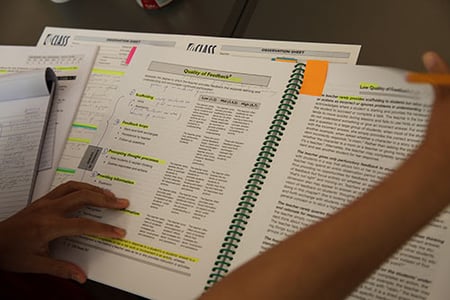
Often, there is a collective shudder when we hear the word “data." Number-crunching can be a dry, tedious task, sometimes resulting from concerns over the implications for teachers/providers and programs. But data is power. We need to embrace it. Data drives critical decision-making, creates efficiencies in time and money, and turns those dry numbers into thoughtful, dynamic action. Data also allows us to be nimble. With a careful plan for quality CLASS data collection, professional development can be designed to dovetail with teacher/provider growth in critical areas of quality teacher-child interactions.
Even before data collection begins, stakeholders at every level must have a common lens for understanding what is being observed so that everyone can identify and understand what is happening in classrooms and work together to make improvements. At Teachstone, we call this “seeding the ground.” We recommend that all observers, directors, and supervisors subscribe to our Introduction to the CLASS Tool program (live or online) to gain perspective and understanding around the CLASS system.
The next step to quality data collection involves analyzing resources. Everyone reading this post manages a critical piece: Teachers and providers manage time; directors, managers, and policy makers manage funds; and there is the omnipresent factor of politics to consider. There is a balancing act of the data you need/want/wish to collect and constraints faced in the field.
So, how should we use those resources, and to what end? We must find the right space between research and practice. We would love to observe every classroom, every month, but that is not fiscally possible. We need to make decisions based on our desired outcomes grounded in context.
I am frequently asked how many observers per program are needed for observations. I used to go into complicated calculations looking at FTEs and length of school day, vacation schedule, and timelines. Now, I just pause and ask: “What are the goals of your observations?”
Most often, data collection takes on one of three models, based on these goals. Data is collected at the:
- Classroom level to design professional development goals and programming for individual teachers;
- Program level to look across centers, monitor program progress over time, and inform funders and help generate grant funding; or
- Grantee level to monitor, gather baseline data, and identify areas for future CLASS data collection.
Look for upcoming postings on each of these models and the special considerations inherent in each. You can also check out our upcoming webinar, Using CLASS Data to Provide Effective Feedback, which will give you some ideas about how to use classroom-level data to improve teaching.
Back to the shudder … In every CLASS-based training and presentation I provide, I pause at a slide that shows our pre-K to third-grade classroom average on the Instructional Support domain which sits at a score of approximately 2 (on a scale of 1–7). There is no need to shudder. Heck, there is no time to shudder. We need to tackle this one critical question, “Now that we have the data, what do we DO with it?” That question alone gives us the power for action.

